#and the closeup of richard holding her face
Text
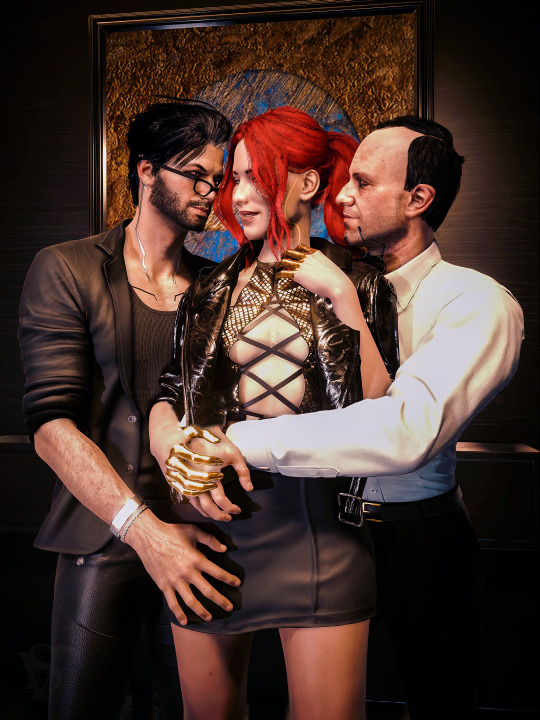
Got you a lil something for your birthday. Hope you like him.
Richard? Little? You've got no idea.
A birthday treat for Val from her two best men, courtesy of @dustymagpie. Thank you for spoiling us!
Val's Birthday Bash
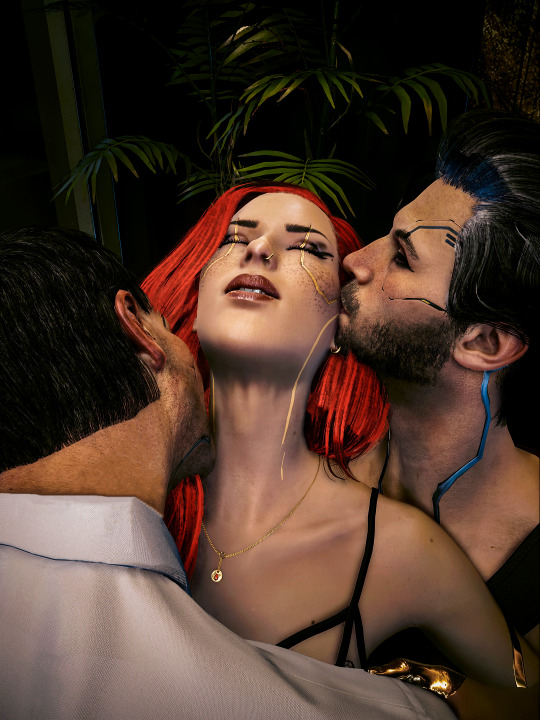





How you feelin'?
Like I need a carton of smokes.
That, uh, good or...?
Really good.
#cyberpunk 2077#cyberpunk 2077 photomode#cp2077edit#cyberpunk photomode#mitch anderson#cyberpunk mitch#richard ripper#valerie vermilion#corpo!val#mitch x v#mitch x fem v#ship: business & pleasure#mitch in corpo!val au#mitch in a suit 🥵#others work#dusty magpie#these are so good kittyyyy#obsessed with her hand on mitch's white shirt#and the closeup of richard holding her face#and his and mitch's lil wave 🥹#thirsty thursday#so thirsty#hands#val sandwich#🥵🥵🥵#nsft#val's birthday bash#but spicy#mitch x val
39 notes
·
View notes
Text
Stage Fright

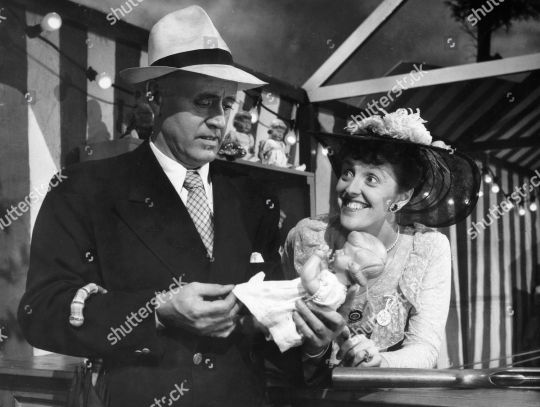

It's impossible to discuss Alfred Hitchcock’s STAGE FRIGHT (1950, TCM) without getting into the ending, so if you’ve never seen it or heard much about it and want to maintain your innocence on the subject STOP READING NOW.
And now the rest of you still reading can join me in laughing at the ones who stopped.
Just joking. But let’s get on with the discussion.
Acting student Eve Gill (Jane Wyman) has a crush on a man (Richard Todd) who tells her, in flashback, he’s been having an affair with an actress (Marlene Dietrich) who’s just murdered her husband. In attempting to cover up for her, Todd claims to have made himself the chief suspect, so Wyman hides him with her father’s (Alastair Sim) help and masquerades as Dietrich’s maid to try to get the goods on her.
Hitchcock always said his mistake in STAGE FRIGHT was opening the film with a flashback that lies. More recent critics (and those pesky French) have hailed the device as a witty subversion of genre expectations. I think it could indeed work that way in another movie. I think if one set up the characters properly, discovering the plucky young woman and her eccentric father had gone to a great deal of bother to protect a guilty man would make for a solid post-modern detective thriller. But here the characters aren’t set up at all before the flashback starts. The film opens on Wyman driving Todd to get away from the police as he tells her his story (which includes seeing Wyman in an acting class at RADA doing a scene from high comedy, and that may be a bigger crime than the story’s murder). It all feels too abrupt, and it seems to take forever to get to know the characters.
Of course, in Wyman’s case there isn’t much of a character to get to know. Hitchcock wanted a star, and he was working at Warner Bros., and she was their top female star at the time. But though she had done good work in lots of other films. she’s all wrong for the role. Eve has to be implusive and energetic and, above all, innocent. When she realizes she’s falling in love with the detective (Michael Wilding) on the case, she needs to be winsome and vulnerable. The younger Wyman could have played that, but after years of fighting to get anywhere at Warner Bros. she’s about as winsome as a Mac truck. It’s like watching Norma Shearer trying vainly to become Elizabeth Barrett Browning or Juliet. The business has kicked all the necessary elements of those characters right out of her. The film drags whenever she’s on screen, which is a lot. Wilding is charming in their love scenes, but he might as well be playing to a brick wall. Fortunately, there are some wonderful British character actors on the periphery: Sim, Sybil Thorndike, Miles Malleson, Kay Walsh and Joyce Grenfell as the lady with the lovely duckies.
And, of course, there’s Dietrich. The woman is a holy wonder, one of the screen’s supreme technicians. When Wyman doesn’t move her face for fear of betraying her age, she projects almost nothing. Dietrich’s face may be even more frozen, but she knows how to move her head, her eyes — it’s almost cellular. Watch the way she holds her feet performing Cole Porter’s “The Laziest Girl in Town,” and you’ll realize what an amazing artist she was. She knows how to write the script with her voice and her body. In the midst of a poorly constructed screenplay, she creates a compelling character who draws you in. When the film has to cut from her final closeup (which is almost breathtaking) to get to the rather clumsy denouement, it’s hard to care what happens to anybody else.
#alfred hitchcock#thrillers#jane wyman#marlene dietrich#richard todd#michael wilding#alastair sim#sylbil thorndike#miles malleson#kay walsh#joyce grenfell
1 note
·
View note
Text
THE CLASSIC ARTIST TEST
One way to test an incoming new artist's storytelling skills is to offer a test plot or script -- a few pages that a top professional artist has already done, so there's a baseline of storytelling standards with which to compare results. This is not about style but, rather, storytelling strength -- clarity, powerful action and movement, and body language/gesture/overall character performance. Often I'll use a plot or script I've written and one of my artists has drawn, for the baseline.
This time, I decided to go back to classic John Buscema storytelling for the comparison. Why flash back to the '60s? Strong storytelling never goes out of style, and such classic superstars as Jack Kirby, John Romita, Gil Kane, Neal Adams, Jose Luis Garcia Lopez, and Will Eisner are among those whose every book can teach something useful. Yet, as the years wear on, fewer and fewer incoming artists are even familiar with their work.
Here's a panel-by-panel plot I provided for a five-page test --
PAGE 1
Panel one -- Full-page splash. Reed Richards is in pajama bottoms and slippers, in a bathroom, shaving. A futuristic alarm (a Kirby Machine in foreground) goes off, catching his attention. The Thing (Ben Grimm) peeks out of the shower, all sudsed up, also reacting to the alarm. Title, credits, indicia go on this page.
PAGE 2
Panel one -- Reed and Ben run through the living room. Ben wraps a towel around his waist; he still has suds on him. Reed, now wearing a robe, wipes the shaving cream from his face with his towel. Johnny Storm also hurries in.
Panel two -- Reed throws open a door to a control room, as a cyclone of wind whips papers,indicating someone or something just exited a window.
Panel three -- Reed reaches for a control panel, seeing a piece of machinery has been stolen, ripped away. A tense Johnny looks around, realizing someone went out the window with it.
Panel four -- Outside the window now: Johnny flames on, beginning the search, as Reed shouts orders after him.
PAGE 3
Panel one -- Full-page splash, in foreground, a concerned Silver Surfer enters a hospital room from the window, seeking to heal a patient. Misunderstanding his intentions, a frantic doctor opens the door, as two cops enter with big special energy rifles. A nurse hunches over, protecting the young woman in the hospital bed.
PAGE 4
Panel one -- Surfer gestures, reaching out toward the patient; nurse and cop warn him away.
Panel two -- Surfer pleads with them to reason.
Panel three -- Surfer casts a cosmic bolt toward the patient as the nurse reacts, fearing the worst.
Panel four -- One of the cops blasts Surfer with his rifle.
PAGE 5
Panel one -- Surfer drops to his knees, smoke rising from him as the cops stand over him.
Panel two -- Now pissed, Surfer gestures, energy flowing from his eyes.
Panel three -- Surfer casts cosmic power from his hands -- which pulls the rifles from the cops' grasp, melting them.
Panel four -- Surfer returns to the window, angered, ready to leave. He points accusations at a cop and the nurse for assuming the worst. He was only trying to help.
Here's an example of what an artist turned in for PAGE 1 --
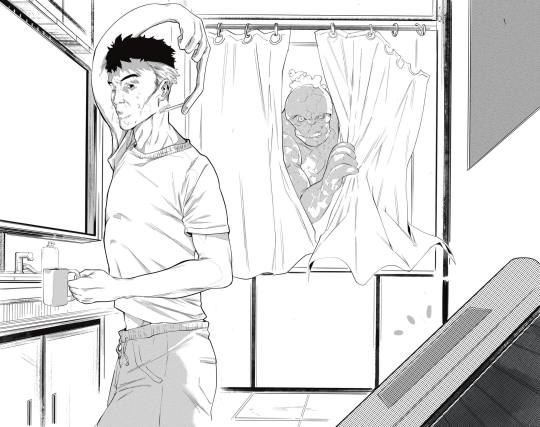
Compare with Buscema's original --

Side-by-side without the title space --
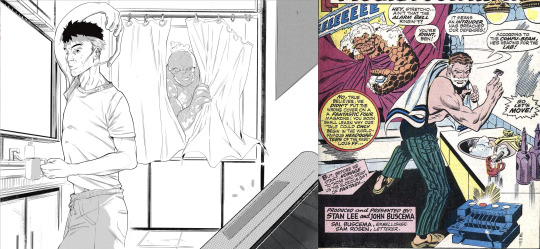
Compare: John Buscema gives us a slight down shot. A more tense, ready-for-action pose from Reed Richards; he's whipping his head around, his face is covered in shaving cream, hot water is running in the sink, the alarm thingie is going off, Ben Grimm is crumpling the shower curtain, all the soap suds are coming up off him. Even Reed's towel feels like it's moving, as if he's just thrown it over his shoulder.
For PAGE 2 --

The original --
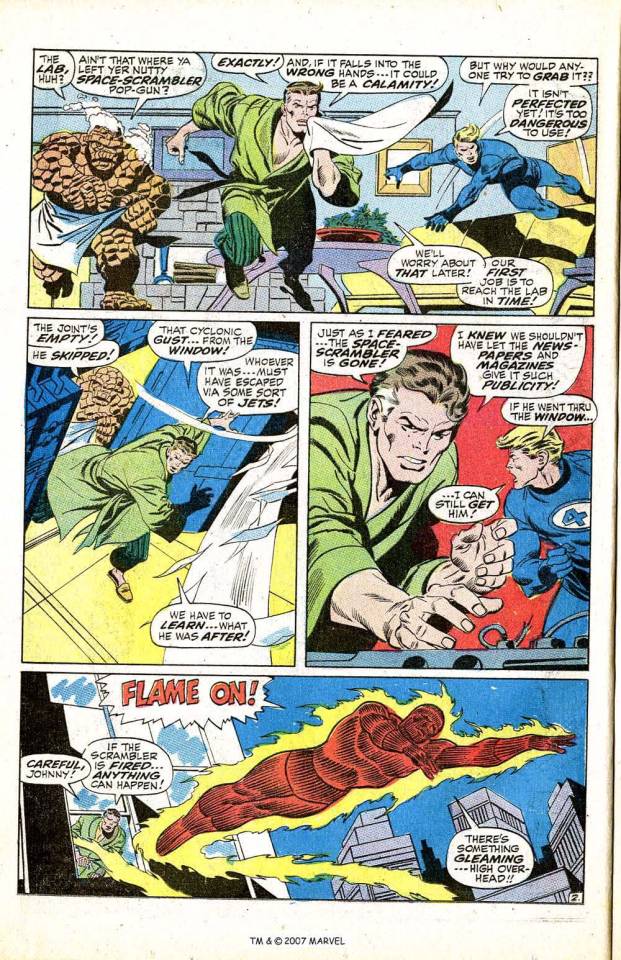
Side-by-side --
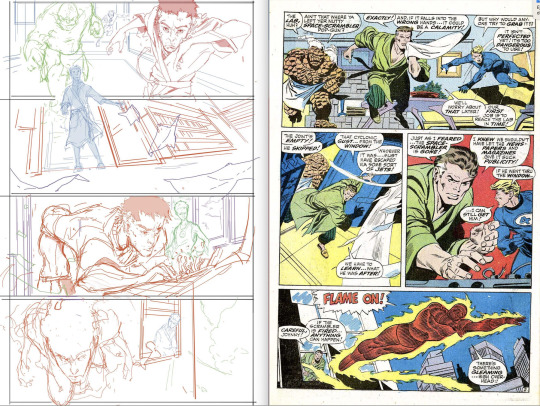
I commented to the artist: In panel 1, you left out any indication this was the living room. Ben's towel is already around him, Reed Richards is looking scrawny and old, no sense of power here. Johnny is almost lost in the back of the hallway. In John Buscema's version, Ben is in the middle of pulling the towel around himself. The soap suds are still coming off him, indicating how fast he jumped out of the shower. Reed has put on a robe; the material is moving, the robe's belt is flying up behind him, the towel is whipping in the air as he wipes the shaving cream off his face, Johnny is leaping over furniture to race toward us. In that quickly-drawn first panel, there's still AT LEAST seven levels of depth to the shot! Reed (level 1); the coffee table (level 2); Ben and Johnny (level 3); the sofa (level 4); base of the fireplace (level 5) the fireplace itself (level 6) opening to the bathroom they just came from (level 7). So lots of depth to a simple shot.
Panel 2, you drew the action BETWEEN the panels. Try never to do that unless the script calls for it. Draw the MIDDLE of the action. You've draw Reed already having opened the door, just standing there doing nothing.Buscema drew a dramatic down shot, Reed shoving open the door, hands up and open tensely, and the papers are whipping in one specific direction, indicating where the thief just exited.
Panel three, you have two skinny, emaciated heroes just standing there. Johnny's looking at the floor or something. Reed is just looking. Buscema drew a concerned-faced Reed reaching toward the wires. Johnny, hand balled into a fist as he's ready to bust into action, is looking around, but he's leaning forward -- he's moving into action.
Panel four, although you drew a nice shot of Johnny flying out toward us, this is the FIRST time in the story we see Johnny flying. Buscema understands that, so he makes sure we see Johnny in full figure, flaming on, speed trail indicating his movement. He also TILTS the building to make the angle more dramatic, clearly showing the city backdrop.
For PAGE 3 --
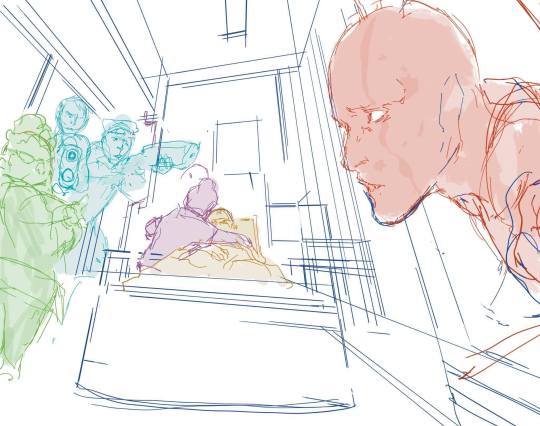
The original --

Flipping the artist's image for easier comparison side-by-side --

My comments to the artist: You drew just the Surfer's head peeking in. You have the cops already in the room, pointing their weapons. How did they know Surfer was going to be there at that very moment? In your version, we cannot clearly see the doctor opening the door to let the cops race in. Her body blocks the door and movement of opening the door. You turned the nurse AWAY from the action, rather than seeing and reacting to the action. And you drew another straight-on angle, with no sense of movement/urgency.
Analyze what Buscema drew: He didn't just draw the Surfer's head. There's enough of the Surfer in foreground, an expressive hand raised. He's facing the woman and the cops, which yours was NOT. Clearly the doctor is yanking open the door, the cops are racing in with their weapons. The nurse sees what's happening and shields the patient with her own body. The angle of the room is tilted TOWARD the Surfer, adding to the sense of drama/movement.
Now PAGE FOUR --

Compared to --

Side-by-side --

My notes: Panel one, You decided to focus on the Surfer, even though his gesturing is the only important element about him in this panel. Most of the panel is about the cop and the nurse, warning the Surfer away. But the way you staged it, much of the cop and nurse and patient are CUT OUT of the scene. In Buscema's layout, the gesture is the focus, BUT we see the cop with his weapon and stern expression. We see the nurse, leaning in forward to warn him away. We see one arm holding her patient, protectively, and her other hand out, expressive.
Panel two, you chose a closeup, nothing else. Buscema chose a 3/4 full body shot, using expressive hands to emphasize that he is pleading with them to be reasonable.
Panel three, I'm not 100% clear what's going on in yours. In Buscema's, it's totally clear that Surfer unleashes his cosmic power to help the patient, as the nurse reacts, her expressive hand visible.
Panel four, I don't understand why you drew the figures posed so incredibly bored. We can't even see how the Surfer's reacting to being shot by the blast. In Buscema's, we see the reaction of the nurse, and the second cop, while the first cop dramatically whips around his weapon, firing at the Surfer, who is hit with the blast. Look at his wide stance and flailing arms. This kind of panel is great for assembling multiple actions is one shot. The wider the panel, the more time has passed. The narrower the panel, the shorter the amount of time. This schematic type of panel allows us to see Nurse reaction/cop reaction/other cop wide-stances, whipping weapon int position/firing/impact blast from the firing/surfer's reaction at being hit -- ALL in one panel. Strong, clear, powerful storytelling.
Then PAGE 5 --
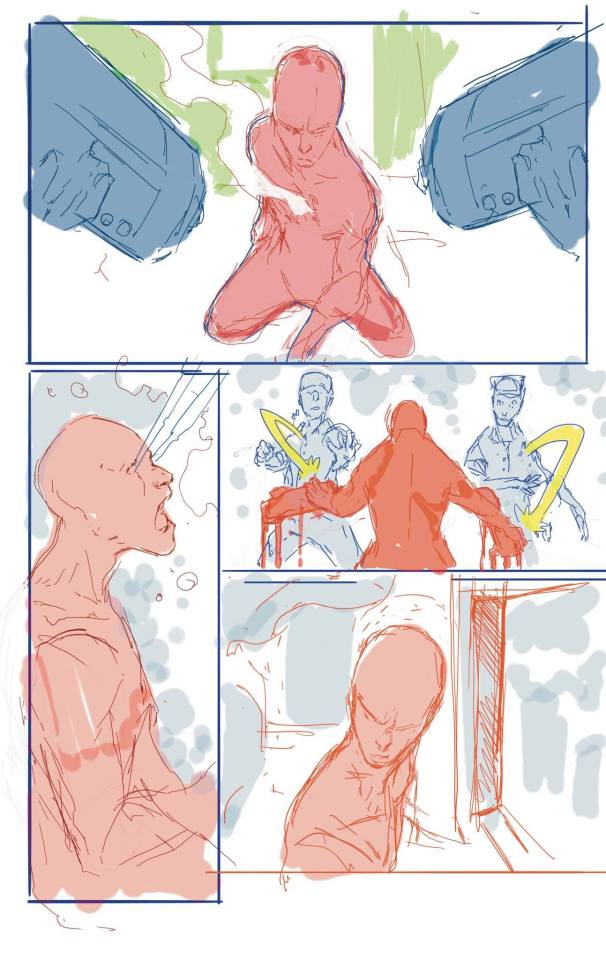
With --
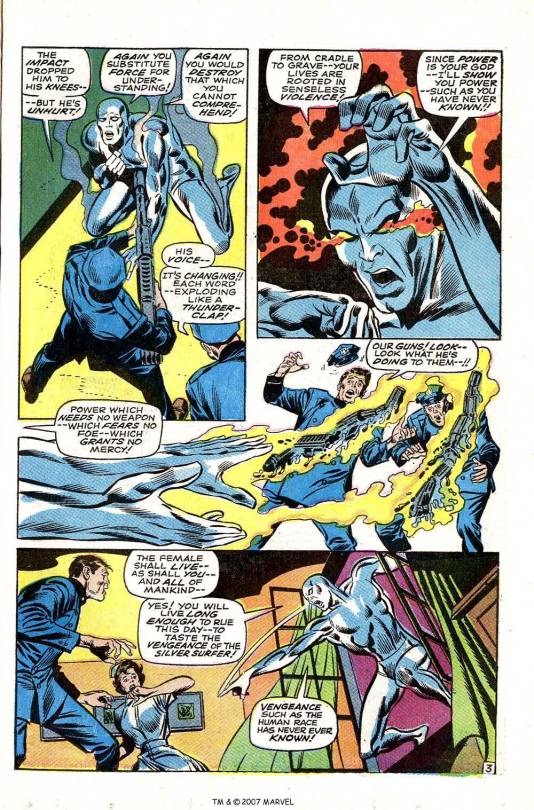
Side-by-side --

My analysis: I notice that you love centering things in the middle of your panel. Buscema does only occasionally; he'd rather try for a more dramatic composition. Panel 1, you draw a down shot on a skinny Surfer who is looking down, away from them, not engaged. Buscema drew a more powerful Surfer, head turned up to look at and speak to them, an expressive fist balled up even as he pushes himself up with his other arm.
Panel two, your Surfer seems to be firing beams from his eyes, which is not exactly what was described. In Buscema’s version, Surfer is summoning up power. We can see his expression of anger. His hands are majorly expressive, as well, as if summoning a spell.
Panel three, you give us a back shot on Surfer and a really NOT dramatic panel. Buscema gave us the clear power blasts from Surfer's hands, the melting-in-mid-air weapons, the two cops' shocked reactions even as they jerk back in fear.
Panel four, you draw the Surfer just looking back over his shoulder to say something. Compare with: Buscema draws a cop and nurse reacting to the Surfer's threat, the Surfer has leapt to the window sill, pointing angrily, the window open and the drapes whipping in the wind.
Understand that Buscema is drawing each page here in about 2 and a half hours. So he's not spending a lot of time analyzing the script, he's just laying it down as clearly and dramatically as he can.
Remember, this analysis for you is NOT about your finished style. It's only about the thinking behind your layouts. I figure you've never taken the time to study classic storytelling, so you're re-inventing the wheel in your own mind. As such, you're not learning what can/should be done.
I hope this helps.
6 notes
·
View notes
Text
VI.
"A happy life can often be a very dangerous thing. Something that other people simply cannot abide "
Major Content Notes:
Blood & Gore: a man is shot in the face, we don’t see the impact but we do see him afterwards with a bloody face, missing an eye including a closeup of his face
Sexual Assault: offscreen, implied
Slavery: a cargo hold full of slaves is shown. One slave is forced against a pillar by a crewman, who is then choked to death. The slaves revolt against their captors, one is shot in the chest, but no injuries are seen and he seems to survive
Wikipedia Synopsis:
Capturing the Andromache proves to be a costly endeavor when Flint loses a few of his crew to Bryson's men who are holed up in the hull. Meanwhile, Anne decides to take a stand against Hamund and his men for harming Max. Eleanor gets a visit from an unlikely ally who needs her help and turns to Silver to form a plan. Billy reads a private letter from Mrs. Barlow asking for a pardon for Flint's murderous actions aboard the Maria Aleyne, and asks Gates to confront him before the men learn of his betrayal. Vane reaches his destination from his self-made voyage.
This episode's got a bit in the way of blood and gore, but most importantly for this series of posts, it's the episode in which we see the end of Max's sexual slavery storyline. After this we're done with sexual assault for the rest of the show
Timestamps:
As ever, all timestamps are from the “Complete Collection” DVDs which includes a Starz logo at the start, as well as a recap. Depending on your source, timestamps may vary a little, which is why I’ve included the timestamp for the opening titles. Timestamps are only given for the start and end of scenes featuring any particularly warning-worthy content
01:16: opening credits
05:18-07:51: the slaves poke a rag through a hole in the side of the ship to signal their presence to the pirates, despite Mr Scott’s refusal to assist in their escape attempt. Bryson’s crew hear movement but do not discover anything
09:52-11:25: Hamund arrives at the Ranger camp and is met by Anne. Jack persuades her not to fight Hamund, and he enters Max’s tent to rape her
28:49-34:35: the woman next to Scott berates him for refusing to help. The pirates return the rag with a metal spike wrapped in it. When one of Bryson’s crew comes down to investigate the noise, Scott betrays the woman, but chokes the man to death when he shoves her against a pillar. The pirates are hacking at the top of the bunker to make noise to cover for the slaves breaking open their chains. The slaves revolt and force their way upstairs with some being shot, but carrying on. Bryson pins Scott against the entrance to the bunker and is shot in the face. Scott opens the door and the pirates overrun Bryson’s crew. We see Bryson crawling towards a barrel on which the two flintlocks have been placed, ready to blow the ship up, before the woman stabs him in the back with the metal spike. There is a closeup of his face
41:13-41:30: some pirates go to pick up the barrels of gunpowder from the bunker. We see a closeup of Bryson’s head. When they lift the barrel they set of the flintlocks, blowing up the bunker
Summary:
The crew of the Walrus are getting anxious, as there are only four hours until sunrise, after which they will likely be spotted by the Scarborough who will easily defeat them. Billy shares his concerns about how little they know about Mrs Barlow with Gates, who is setting the pirates’ new plan into action. One of the black pirates has been covered in soot and given a bomb. He is to sneak up to the entrance of the bunker in the pitch black, light the bomb, and throw it through the murder hole. With Bryson and his men choking on the smoke, the pirates should be able to then break down the door
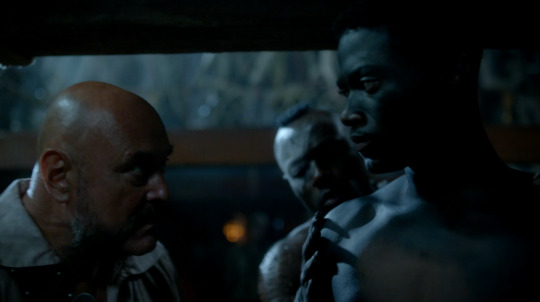
Belowdecks in the hold, one of the slaves passes a rag forwards. The woman next to Mr Scott asks him to poke it through a hole to signal to the pirates. Scott refuses, saying that he doesn’t care about the slaves’ chance for freedom because the weapons the pirates mean to take are very dangerous to someone he loves and, no matter what, the weapons must not be returned. The woman stands up and pokes the rag through herself. Bryson’s crew hear the noise and one comes down to have a look around but heads back upstairs without noticing anything
In the tavern the members of the would-be consortium are waiting for Eleanor to make up her mind about lifting the ban on Vane, and have been for two hours. Captain Narf is optimistic, Frasier seems more grounded, Captain Lawrence is pacing, whilst Hornigold is staring daggers at her door. Eventually Eleanor comes out and nods at Hornigold who says he’ll tell Lilywhite and the crowd listening to him they can stand down and Vane can hunt again. Mr Hamund, and what remains of Vane’s crew snicker, and Hamund blows her a kiss
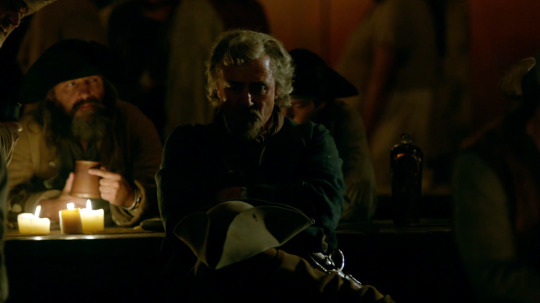
Hamund returns to the Ranger’s camp, triumphant. Max hears him and is clearly scared. He finds Anne waiting outside Max’s tent defiant. Hamund tells Jack to talk some sense into Anne. After Jack has a word with her, Hamund saunters past her, chuckles, and takes a swig of booze and he enters the tent. Jack & Anne exchange a look and Jack leaves, looking concerned
“It would appear that I have failed to appreciate how deeply this situation has disturbed you, but if you’re intent on following this course of action, then I suppose we should do our farewells now, because I don’t think I could stomach watching the men throwing you in that tent as well and having their way with you, which is where I fear this story ends. Unless you pull your shit together”

Billy goes into a cabin on the Andromache to read the letter from Miranda which we hear in her voice. Intercut with this are shots of her writing the letter, as well as the pirate with the bomb being sent below and creeping toward the bunker
“To the honourable Justice Addington Thomas, Massachusetts Bay Colony,
I petition you under the advisement of your friend, Mr Richard Guthrie, to bestow your favour and influence. You may know Captain James Flint by reputation, through stories of his past misdeeds, but you might not know of his desire to repent. He is a good man, a decent man, eager to renounce his transgressions at sea and seek life in a part of the world willing to accept a man humbled and penitent were such a thing possible, would such a place exist.
It is with this very hope that I write you today. I have enclosed a bill of exchange for £500 to be spent at your discretion toward procuring whatever permissions necessary.
I only urge speed. He is caught in a dangerous plot with wicked men, who will most certainly kill him when they learn of his betrayal.
Believe me, your obliged and faithful servant, Miranda Barlow”
As he pauses to light the fuse, one of Bryson’s crew moves slightly, and the beam of light from the bunker shifts. As it does, the pirate tenses, before breathing a sigh of relief. Hearing this, Bryson’s lieutenant fires, killing the pirate. Hearing the shot but no bomb, the pirates on deck are disappointed, and Flint demands Gates give him another plan. Below decks, we see Bryson working with two flintlocks (presumably from spare muskets or pistols), each with a length of string

Billy pulls Gates over to speak to him about the letter, pointing out the word “betrayal” and saying he knows about the Maria Eleyne. As they argue, Flint comes over and casually asks if everything is alright, at which Gates says Billy has come up with their next plan
“I know Flint killed those people for her. I know Morley saw it and brought it to you and I know you did nothing. He played games with his crewmen’s lives then, he’s doing it again now and he knows he can get away with it because we’re protecting him, because you are protecting him”
“Enough! You want to go to the crew with this, be my guest, but I will do everything in my power to frustrate you, know that”
“How can you say that?”
"Because we’re in fucking battle right now and I will not undermine his control of what is frankly a shitty situation based on a letter written by a woman neither of us know a thing about”
Pastor Lambrick rides up to Miranda’s cottage. When she comments that it’s later than she is comfortable receiving guests he tells her that he knows that Mr Guthrie has betrayed Captain Flint, with her help and, whilst Guthrie is safe on Mr Underhill’s plantation, she has no protection. She tells him he doesn’t understand any of this and invites him onto her porch
Meanwhile Eleanor is watching the town from her balcony and is surprised by Anne. She insults Eleanor before asking her help, asking her to kill Hamund for her, saying she would do it herself, but because the crew saw their argument she’d get the blame and get herself killed. Eleanor says that if she has Hamund killed that isn’t much better, and now it may come to her doorstep too. She says she isn’t rejecting the plan because it’s too dangerous, but because it’s not dangerous enough. Instead she proposes killing all 8 of the remaining crew of the Ranger tonight and that they just need a little help to do it
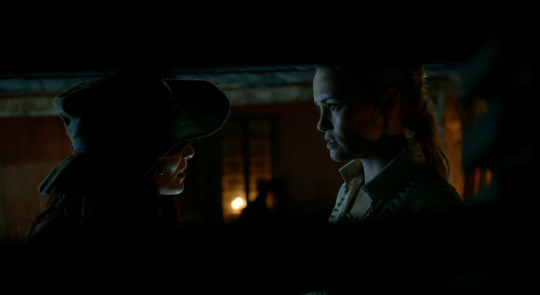
Inside her office, Flint heard the conversation and refuses to help. Eleanor points out that his plan to not be killed after Flint captures the Urca is to become friends with him by then, and that, having spent a while with Flint, he ought to have realised that he doesn’t seem the sort of man to leave a loose end like Silver hanging. She then points out that she has just managed to set herself up as fence again and, as the centre of commerce on Nassau, Flint won’t want to be her enemy, making her probably the only person on the island who could dissuade Flint from killing him
Back at Miranda’s cottage, she explains some of her past life in London, her husband Thomas, Captain Flint, and how she came to arrive in Nassau. She gazes wistfully as she mentions Thomas’ death
“I had a very different life before I came here. A life I shared with my husband. He was, a special men. A man of ideas. About the world. About the order of things. Writers, artists, men of science, they’d fill our drawing room night after night, to talk and argue, sometimes just to listen to him. In some ways he was like you. A shepherd to his flock. He would have loved to have met you”
“Me?”
“You think I can play Devil’s advocate? Thomas would have played that game with you from dusk until dawn and everything you hold sacred, he’d leave in tatters. Not from malice or hate but from love, from a desire to see the yoke of shame lifted from your shoulders”
“You think I am ashamed?”
"My husband and I were happy. But in London a happy life can often be a very dangerous thing. Something that other people simply cannot abide. Thomas learned that lesson all too well. Captain Flint was Thomas’ closest friend. And after his death he saw fit to spirit me here for my own safety”
“Flint brought you here? You’re right, I don’t understand”
“I just told you, Captain Flint is my deliverer. There’s nothing more you need to understand. Why are you here?”
“I’m concerned for your safety”
“It’s late, you knew I’d be alone, it’s inappropriate. You’re not here because you want to protect me, pastor. You’re here because you want to fuck me”
She smirks flirtatiously, pulls him towards her and kisses him. They have sex against the railing of the porch, but he does not last long
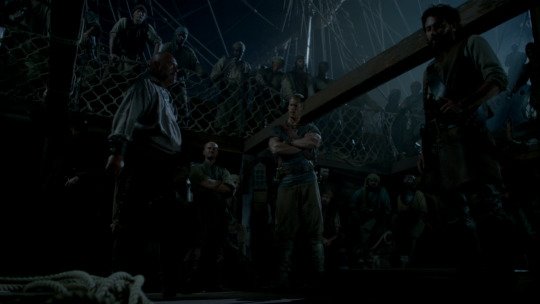
Gates proposes a new plan to the crew, where four men are suspended over the side of the Andromache with axes, augurs, and charges with the goal of making a hole in the hull big enough to put explosives through to let the pirates breach the bunker, saying he saw the famous pirate Henry Avery try it. Logan is skeptical
"Saw Avery try it once”
"And it worked?”
"Said I saw he’d tried it”
Flint asks for volunteers, but when none step forward, he picks four men himself, including Logan who objects that it’s suicide. As Flint reiterates the order, Logan repeatedly appeals to Billy, who stays quiet, eventually Gates punches him clean across the face, kicking him on the way down knocking him out and says, whilst the crew look on shocked
“Mr Logan makes a valid point, unfortunately, now is not the time.
Anyone else got a point they would like to make?
While we are in battle, the captain’s orders are the law, that is what we signed up to, that is what we agreed. Now the order’s been given. Heed it!”
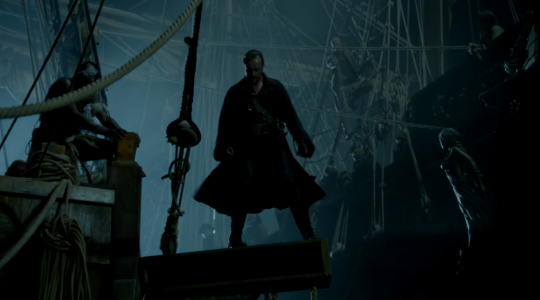
A whistle is heard from the rigging, the slave’s rag has been spotted. Flint walks over to a beam off the side of the Andromache to see it before rushing into the cabin and flicks through several ledgers before finding that the cargo includes 38 slaves, and that 9 are priced over £100, and that 9 strong men ready to fight Bryson from below
"Given their current situation, my assumption is there are no 9 men on earth that wouldn’t jump at the chance for a little fight. What, have you got a better idea?”
Below decks, the woman next to Scott tells him that he will never see the person he loves so much, and that when they get to their destination he won’t be treated any differently than the rest of them
"How many times must you have told yourself that? That you’re special? That your master thinks you’re different from the rest?
Maybe you’re right, but I know those men better than you and when they put you in these, they don’t mean to let you go. You have a chance to go home again, but you just sit there.
Maybe you’re right. You and I are not the same”
The rag is poked back through the hole, this time with a metal spike in it. One of Bryson’s crew comes down to investigate the noise again, and Scott betrays the woman. The crewman then hauls her up to her feet by the throat and shoves her against a pillar, at this point Scott stands up, and chokes the man to death with his chains. He is clearly disturbed at having killed a man
The crew of the Walrus are hacking at the roof of the bunker with axes, making noise to cover for the slaves breaking apart their chains. Bryson is suspicious and then notices the sound of chains clanking from below. He sends his lieutenant down with two men, but they are grabbed by the slaves on the stairs and overrun. As the slaves rush up the stairs, some are shot, but they keep going. Bryson pins Scott against the entrance to the bunker but is shot in the face by a pirate through the murder hole. Scott opens the door, letting the pirates in, and we see Bryson, with a bloody ruined eye (including a closeup of his face) crawling on the floor towards a barrel to which they’ve attached the flintlocks as a sort of self-destruct. Bryson is stabbed in the back by the woman and both she and Scott nod at each other in thanks, as they notice the barrel

Silver approaches Hamund as he’s pissing off the end of a pier. He says that he was Max’s partner, and escaped from the wrecks with his anonymity intact and that he wants to sell Hamund the contents of the page. Hamund takes a while to catch Silver’s subtext before eventually telling him
"We don’t have any fucking money left, you shit! Rackham lost it chasing you!”
“I fail to see how that’s possible”

Anne & Jack are in their room in the brothel when Hamund bursts in with the crew. He tells Jack that Silver told him
"Now I’m told that you gave half our pearls to the whore up front before you ever left for the wrecks, which would mean that half the pearls never went to the wrecks. It was on the whore when your bitch reeled her in leaving us to wonder, where the fuck are they now?”
“I don’t know where you’re getting your information from, but I can assure you it is mistaken”
“She threw that whore into the tent, long before we got to her”
“Yes, but the whore had no pearls! Neither I nor Miss Bonny would be so stupid as to steal from you and even if I were, I would never be so stupid as to trust a whore to act as escrow. Someone is lying to you. Tell me who it was I might be able to help you figure out why”
Throughout all of this Jack looks confused, but Anne looks on coolly. Hamund then produces a small handful of pearls, saying they found them in Anne’s tent, and that this proves he’s right. He demands to know where the rest are, and Anne says they’re buried by the wrecks. Jacks says how disappointed his in her before being grabbed by Hamund

As the pirates are hauling the cannons onto the Walrus, Flint talks to Mr Scott, saying he was surprised to find him in the hold after he betrayed them to Mr Guthrie.
"You think what she and I hope to achieve for Nassau is impossible? That I’ll be the death of her?
I lost six men chasing down this ship, nearly faced another mutiny all over again. If I had any sense I’d throw you to my crew, take the pressure of me.
But I’m not going to do that. I’d rather prove you wrong”

Gates calls Billy over, and tells him he is on Billy’s side. Billy says that then Gates needs to get them some answers. Belowdecks in the bunker two of the pirates comment that there’s perfectly good powder. We see a closeup of Bryson’s face and then, as they lift the barrel, they inadvertently trigger the self-destruct, causing a huge explosion
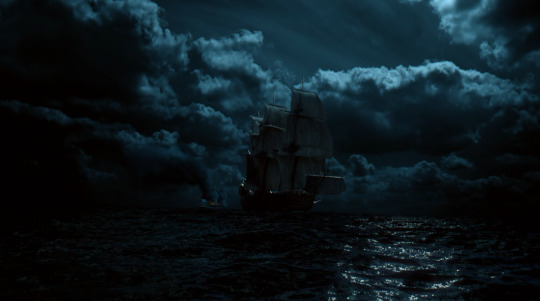
The pirates are knocked flat and gathering their wits, but quickly realise that the Scarborough must have seen that. Flint makes the call that they need to leave, even though there are still three or four guns in the hold. As they sail away they notice the Andromache’s spritsail brace is banging against the hull, having been sent flying by the blast, and that this will be losing them at least 2kts of speed. Billy and Flint climb the bowsprit to cut it loose. As they are sprayed by the full force of the waves, with no rail to brace against, Flint asks Billy about the letter he spoke to Gates about
"Earlier, when you and Mr Gates were having words, you mentioned a letter. What was in it, Billy?”
"Billy, what was in it”
“I think you know what was in it”
Billy finishes cutting the debris loose just as we hear cannonfire. As they are hit, Gates orders them to come about, and Flint calls man overboard as he returns to the deck, telling Gates he fell. The crew call out for him, but no sign can be seen. Gates accepts that they can’t stay to look for him because the Scarborough will tear them to pieces

Jack & Anne are leading the Ranger’s crew through the rocks by the wrecks, as Jack tries to talk her out of the plan
"Ambush I presume? Nothing out there but men with pistols and swords. I imagine those pearls didn’t just materialise though out of thin air, with whom did you scheme this?”
"The cunt”
"Somehow not surprised. Decent fellow Slade, as far as I know never raised a hand against the whore, a factor I hope you considered before you decided that he and six other men who stood by our captain in his darkest hour, men he considers his brothers be lumped with the cost of assuaging your offence in this matter. God damn it Anne. Do I not deserve a say about this?”
"You’ve had your say. Now I’ll have mine”
We intercut between Silver talking to Eleanor in her office and the ambush itself. Hamund tries to limp away, but is caught by Anne who stabs him in the belly. He tries to grab her throat but there is little strength in it and he falls down dead
"When I first met you, I pegged you for an easy mark, but now, between you and Flint, I’m not certain who I should be more afraid of”
I saw you earlier, after you lifted the ban. You were angry.
Not just about Max.
Those men out there, they made you admit you were wrong.
They made you feel weak and I think you felt compelled to let everyone on this island know that in this place no-one fucks with you and gets away with it”
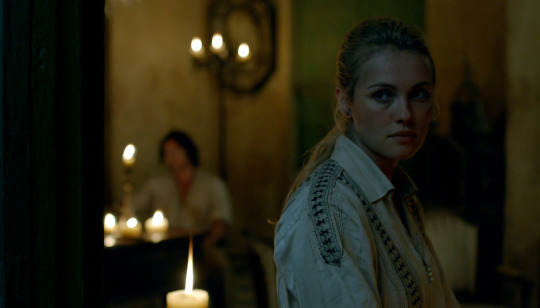
One of Eleanor’s men comes in and nods at her. We then see Max walking up the stairs at the brothel to her old room. She thanks Anne who tells her that she “didn’t do it for you”, before sliding down against the wall crying
On the Walrus the crew hold a funeral for the pirates killed taking the Andromache, with Dufresne reading their names as they are dropped off the side of the ship wrapped in a shroud and chains. They read Billy’s name last and, after a huzzah, Flint ceremonially throws his sword overboard

Jack is in the brothel as Anne comes over and pours herself a drink. Jack is cross with Anne for forcing him to betray his crew
“I hope you’re pleased with yourself. I see we won’t be speaking of this again I presume? Well, before we close the lid on this and put it in the ground, one last question if you will, just to satisfy my curiosity: when you and Miss Guthrie were plotting this little coup, when she asked you ‘well shit Anne what makes you think old Jack will go along with this plan of ours and not plead the truth to his men as he’s most certainly going to feel duty bound to do?’ What did you say?”
“I told her given the choice between them and me, you’d choose me”
"That’s very fucking touching. And the captain? The two of you come up with some idea how to deal with him when he returns and finds out about all this?”
"You don’t know where he’s gone do you? He ain’t coming back”
We cut to Vane landing his skiff by a fire in some woods where the large bald man is waiting. As he stands up, the two hold each other’s gaze before cutting to the end credits

0 notes
Photo
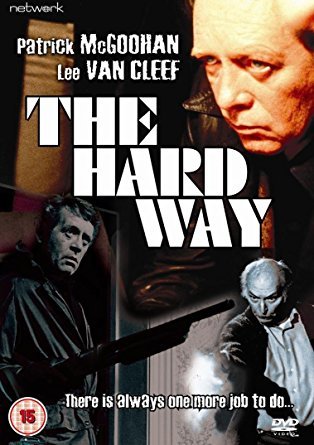
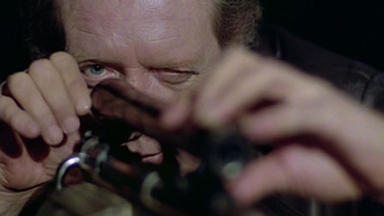

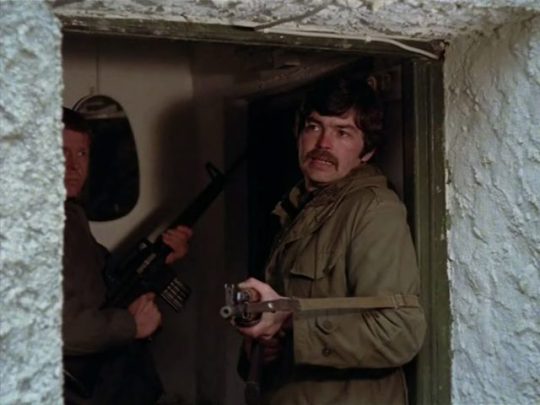




The Hard Way (1979)
“You tell him from me - this is the last.”
There isn’t a lot of information out there about The Hard Way, making it a bit of a mystery. It was produced by ITC in 1979 - that much is fact - and appears to have been intended for theatrical release. ITC had been moving steadily from TV to film production throughout the 1970s, although their films had always been licensed to other companies for release. 1979 was the year this changed, as ITC partnered with Thorn EMI Screen Entertainment (itself a conglomerate of the seperate Thorn and EMI entities, also a 1979 baby) to produce Associated Film Distribution. AFD would distribute films made by both ITC and Thorn EMI, as well as any other films the companies could pick up and sell.
AFD would be a short lived disaster, producing two of the biggest flops of 1980 before being unceremoniously wound down (prompting the retirement of ITC head honcho Lew Grade into the bargain). Those two films, incidentally, were Can’t Stop The Music (a musical-comedy faux biopic of The Village People, released just as disco was going out of style, and which inspired the Razzie awards) and Raise The Titanic (an overly long, incredibly expensive adaptation of a Clive Cussler novel that was absolutely trashed by Cussler himself). These were two hugely costly mistakes that lost millions of dollars. So why had the cheap, safe The Hard Way not made it into cinemas the year before?
I don’t have the answer, I’m afraid. Like I said, details are sparse. A little digging around, however, does hint at a troubled production. The script was written by Kevin Grogan and Richard F. Tombleson (actually Richard Ryan), with Tombleson to direct, Michael Dryhurst to produce and John Boorman to act as executive producer. How exactly a director of Boorman’s stature got involved with this minor production is also shrouded in mystery, though its worth noting that the film was made almost entirely in Ireland (where Boorman had long been based) and that the director was fresh from his own cinematic disaster (1977’s absolute mess Exorcist II: The Heretic, once described by Mark Kermode as “demonstrably the worst film ever made”). Whatever happened next, Tombleson was soon dropped as director and replaced by producer Dryhurst - anecdotal legend has it that either Tombleson found the ‘hard living’ nature of his cast too much to deal with, or that he clashed (personally or professionally) with star Patrick McGoohan.
Dryhurst had experience as an associate producer and as an assistant director, but this was to be his first project in the senior positions (his only credit as director, in fact). Whether or not ITC lost confidence in an inexperienced crew, or doubted the financial return of such a quiet, maudlin film, is pure speculation. I just don’t know (sorry, I never promised to have answers). Whatever the case, the film never got a theatrical release and instead became a TV movie and, in a few years, an early home video release. There it seems to have picked up a (very) small but devoted following.
The plot is nothing much new; McGoohan is John Connor, an aging hitman who works for hire, usually for a mercernary organization headed by McNeal (Lee Van Cleef). Connor has retired, but McNeal needs him for one last job and eventually pressures him to come out of retirement by threatening Connor’s estranged wife. Connor doesn’t go through with it, McNeal loses face and orders him killed; the scene is set for a suitably dramatic showdown. This isn’t groundbreaking, or even particularly special. But the final product is, just a little, special. Something went right, somewhere along the line, and The Hard Way turns out to be a surprisingly memorable film. I’m not saying ITC would have made a fortune, had they distributed the film to cinemas, but they certainly wouldn’t have lost millions and I’m sure it would have at least broken even…
The best word I can use to describe this film is sparse. Everything is just a little bleak, a little grey. Country landscapes are autumnal, grubby and wet. City shots seem especially grimy and gaunt. Dryhurst - who actually equips himself pretty well as a first time director - eschews closeups and keeps everyone at a middle distance, where its difficult to properly read their faces. Even the script is sparse. The whole film revolves around Connor and he’s not often offscreen for any length of time, yet he has only a handful of lines in the entire thing. Dryhurst didn’t even use an original score, instead using two ready-made pieces from Brian Eno’s 1978 experimental album, Music For Films.
The cast (Van Cleef and McGoohan aside) are mostly semi-familiar faces from British and Irish television - Donal McCann, Joe Lynch, Kevin Flood. The notable exception is Connor’s wife, Kathleen. Played by celebrated Irish novelist Edna O'Brien - in her only credited screen role - Kathleen spends most of the film isolated from the other characters. She provides much of the background and insight on Connor, delivering melancholy monologues directly to camera in what looks like a cave. Its disconcerting at first, having such a particular tone and presence for just one character (the context of her one sided conversation and its setting is not revealed until the very end of the film) but it ends up working. As the very human side of an inhumane business (Kathleen is the only truly sympathetic character in the film) she anchors everything in a state of reality and consequence. Its what prevents the film from becoming just another generic action film, or an overly grim mood Piece; the idea that though Connor is A Bad Man, and not really suited to any other life, there was a time that he was capable of love, when he was a husband and a father and not just a man with a gun.
Really though, the film belongs to the two stars - it was always going to. Van Cleef is Van Cleef; an actor who, although typecast early on as villains and murderers, was always elegant and subtle in his performances. As McNeal he is the other face of the coin to McGoohan’s Connor. Both men are getting old and getting tired, but where Connor is determined to quit, McNeal is more than ever obsessed with carrying on. His demand that Connor perform the fateful hit feels less about ‘hiring the best’ and more about preventing someone from taking the easy way out. “Men like us don’t stop”, he tells Connor when they first confront one another. In that line is his major misunderstanding of the situation, the idea that he and Connor are the same, with the same goals, drive, needs. He offers more money, but its clear from the very beginning that Connor has never been overly interested in the pay - he takes enough for himself and sends the rest to his family. “I have enough”.
McNeal is proved right in the end, in that both men find themselves unable to stop once the wheels are in motion. The final showdown - Connor entering a certain trap, McNeal rigging the house with tripwire and microphones - is a minor masterpiece of its kind. Connor is wounded early in the scene and spends the rest of it prowling around, using one arm to fire his shotgun at anything and everything that spooks him. Its a paranoid moment but you never feel like Connor has lost control - rather that he’s beyond caring, or has made peace with whatever outcome he expects.
McGoohan is incredible in these scenes, as he is throughout. As I said, he gets precious little dialogue, but it works to his advantage. Always a very physical actor, McGoohan hunches his shoulders and stalks his way slowly through the film conveying his feelings and reactions with a tilt of the head or a movement of his hand. There is a moment where Connor recieves a letter from his daughters, emigrated to America, and begins a reply. Its a simple enough scene, but as Edna O'Brien speaks in voice-over, about how he was a good father, but distant too, McGoohan holds the letter from him; he wanders to the window, stares out as if considering his reply; goes to put the letter down and apparantly move away; has second thoughts, sits and looks at the letter again; slowly, hesitantly pulls a piece of paper towards himself and picks up a pen; holds the pen as though he doesn’t know what to do next and finally, almost resigned, begins to write. Its a fantastic piece of theatre which is a lot more subtle played out than it is described here - the quiet, controlled, fastidious killer faced with the one aspect of his life which visibly makes him uncertain, which he can’t entirely control, which could be exploited as his weakness (as Kathleen is). It’s never really explained why the kids are in America, but watching the film you can’t help but feel its at least partly because Connor had no idea what to say to them.
#the hard way#patrick mcgoohan#lee van cleef#edna o'brien#donal mccann#joe lynch#kevin flood#michael dryhurst#richard tombleson#kevin grogan#itc#lew grade#raise the titanic#can't stop the music#john boorman#this is too long#mess#but yah
20 notes
·
View notes
Text
Bullitt County

"Bullitt County" has more talent than sense. This thriller from writer/director David McCracken about four friends getting into a heap of trouble in the Kentucky mountains circa 1977 owes a huge and unabashed debt to the Coen brothers, to the point where the movie's PR material felt emboldened to compare itself to "No Country for Old Men." And there are, in fact, several moments when you can't help but think of the brothers' mordantly funny kidnapping pictures, especially "Fargo" and their debut, "Blood Simple." The problem is the script, which isn't up to the level of the filmmaking—much less the acting, by a crackling ensemble of new and established players who deserve to become better known as a result of their work here.
At the center are four friends who decide to visit their favorite distilleries on the bluegrass bourbon trail, retracing a course they embarked on ten years earlier. While stopping by a personally significant distillery (one that's since been converted into a beer place, alas) they hear of a stash of bootlegging loot that's supposedly buried in the Bullitt County woods, and decide to go find it. And as you can imagine, things don't go as planned.
Intertwined with their treasure hunt is a personal story about guilt, sin and repression. The film's main character Gordie (Mike C. Nelson), a Vietnam veteran, is afflicted by PTSD—not from his military experience (he got sent home before he saw action), but from something horrible that happened to him stateside a decade ago, in the company of the trio he's traveling with now: Robin (Jenni Milear), a guitar-strumming wiseass; her even bigger wiseass of a boyfriend Keaton (David McCracken), who always seems to say and do the worst thing at the worst time; and Wayne (Napoleon Ryan), a soft-spoken Englishman who mostly hovers on the periphery and interjects commentary on Gordie's choices, and whose look and body language faintly recall a young Art Garfunkel.
Along the way, the group meets eccentric locals, played by character actors who make their roles pop even when they have a couple of scenes or a handful of lines. The performers go the extra kilometer to make every character's choice feel spontaneous and real, even when they're just doing whatever the movie needs them to do to set up the next big moment. The most impressive are Richard Riehle and Dorothy Lyman as an older married couple who offer hospitality to the foursome. They have John Ford faces.
McCracken is a sharp director of uncomfortable conversations and emotional assaults as well as beatings and killings. He, his cinematographer Sean McDaniel, and his editor Kevin Del Colle always try to present things in a way that's elegant and surprising but not pointlessly showy, in the manner of a classic Hollywood movie from a time when every camera move, even in bad films, was meaningful, or tried to be. My favorite occurs when violence erupts in a small room, and the movie holds on a long closeup of a shocked, blood-spattered character in the foreground while the kitchen window in the background forms a frame-within-a-frame that other major characters gather within.
Unfortunately, this is a textbook case of an otherwise assured movie outsmarting itself. The details of Gordie's trauma are doled out gradually, by way of flashbacks that don't fill in the whole story until the final scene, at which point we're treated to a twist that would be shocking if we hadn't seen it done over and over during the last couple of decades. The movie takes a story that could have been horrifying and sorrowful—part treasure hunting thriller, part lament for moral cowardice, in the vein of a great Coen brothers thriller, or a backwoods tragedy like "Deliverance" or "A Simple Plan"—and makes it seem shallow and gimmicky, by piling on commercial screenwriting cliches.
It's a shame, because McCracken has real directorial chops, and his cast does fine-grained detail work—Nelson especially. His dyspeptic, volatile, wounded performance somehow channels both Paul Giamatti and the young Jack Nicholson. Even when the movie defeats itself, he's in there turning a bundle of contrived storytelling cues into a witty, grotesque, self-pitying, scary man. Gordie's story would have held our attention if we'd been privy to the source of his anguish from the start. The deeper we travel into the maze of "Bullitt County," the more you may wish it had settled for being a straightforward character drama with suspense trappings, instead of a puzzle-box movie. The cast and crew have an American classic in them, but this ain't it.
from All Content https://ift.tt/2qa9Q5X
0 notes